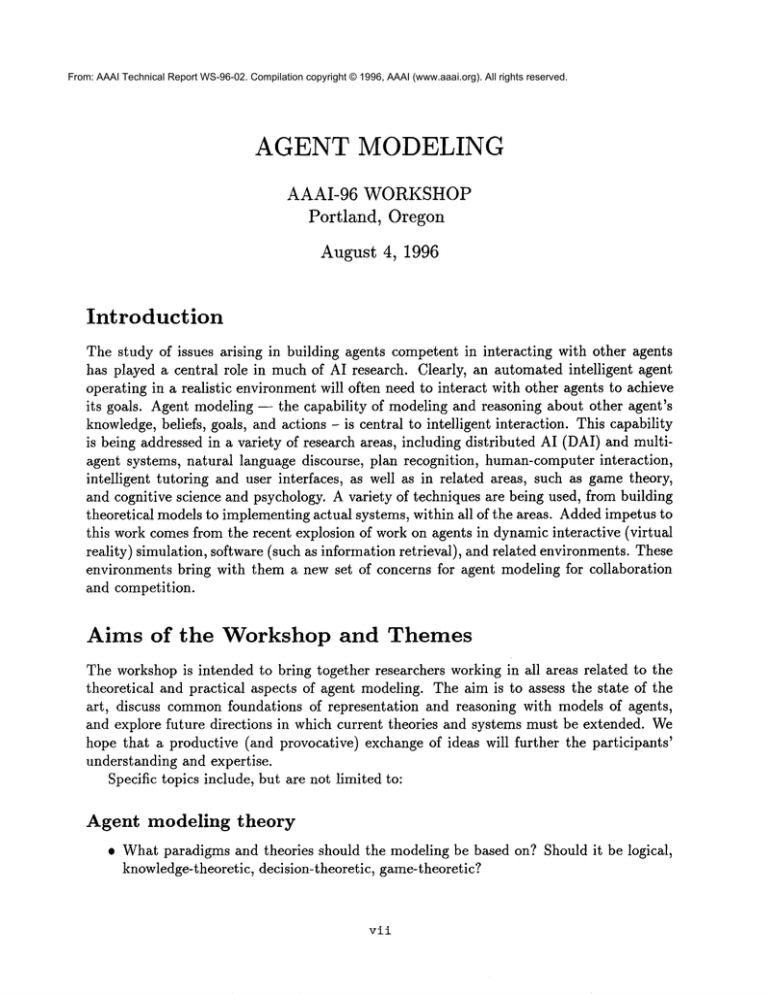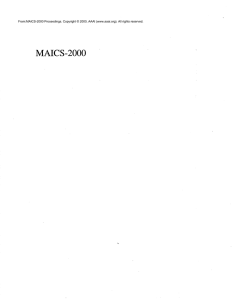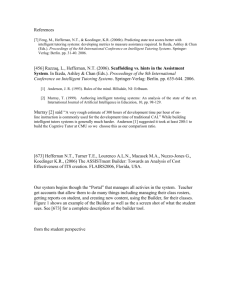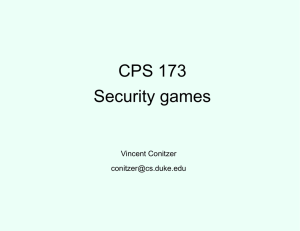
From: AAAI Technical Report WS-96-02. Compilation copyright © 1996, AAAI (www.aaai.org). All rights reserved.
AGENT MODELING
AAAI-96 WORKSHOP
Portland, Oregon
August 4, 1996
Introduction
The study of issues arising in building agents competent in interacting with other agents
has played a central role in muchof AI research. Clearly, an automated intelligent agent
operating in a realistic environmentwill often need to interact with other agents to achieve
its goals. Agent modeling -- the capability of modeling and reasoning about other agent’s
knowledge,beliefs, goals, and actions - is central to intelligent interaction. This capability
is being addressed in a variety of research areas, including distributed AI (DAI) and multiagent systems, natural language discourse, plan recognition, human-computerinteraction,
intelligent tutoring and user interfaces, as well as in related areas, such as gametheory,
and cognitive science and psychology. A variety of techniques are being used, from building
theoretical models to implementingactual systems, within all of the areas. Addedimpetus to
this work comesfrom the recent explosion of work on agents in dynamic interactive (virtual
reality) simulation, software (such as information retrieval), and related environments. These
environments bring with them a new set of concerns for agent modeling for collaboration
and competition.
Aims of the
Workshop and Themes
The workshopis intended to bring together researchers working in all areas related to the
theoretical and practical aspects of agent modeling. The aim is to assess the state of the
art, discuss commonfoundations of representation and reasoning with models of agents,
and explore future directions in which current theories and systems must be extended. We
hope that a productive (and provocative) exchange of ideas will further the participants’
understanding and expertise.
Specific topics include, but are not limited to:
Agent modeling
theory
¯ What paradigms and theories should the modeling be based on? Should it be logical,
knowledge-theoretic, decision-theoretic, game-theoretic?
vii
Whatlevel of modeling is appropriate for different tasks? Is it always the case that
treating agents in terms of knowledge,beliefs and desires is better? Can they be treated
as simple mechanisms?
Whatare the methods for making use of the models? Howis the information contained
in the model being processed?
Are there special concerns in modeling groups of agents?
Agent modeling in practice
¯ Can the models already considered, either in gametheory, or in psychology, be used
in AI applications?
Are theoretical models developed for agent modeling in DAIof relevance for building
intelligent tutoring systems? Dothese tutoring system offer new insights into agent
modeling, or possibly present harder problems that we might have otherwise expected?
¯ Howdo concerns of real-time performance and reactivity
environments change the nature of agent modeling?
Agent modeling
in the synthetic simulation
and communication
¯ Whatare the implications of various approaches to modeling for intelligent communication? What is the relation between the models and the communicative acts?
¯ Howcan what is knownabout human-to-humaninteraction
tion of humanand artificial agents?
Agent modeling:
be applied to the interac-
Learning and representations
¯ Howcan agents learn/acquire
models of other agents (including humanusers)?
¯ What representations emerge as commonacross the subfields and applications?
there any promising alternatives?
Submission
Are
information
Interested participants should submit a 10 page extended abstract (12 pt font). Westrongly
encourage email submissions of text/postscript files. If this is not possible, please send
four hard copies to the following address: Milind Tambe, Information Sciences Institute,
University of Southern California, 4676 Admiralty Way, Marina del Rey, CA90292, email:
tambe@isi.edu.
viii
Important
Dates
Deadline for submission and request for participation:
Notification of acceptance:
Final date for camera-ready copies to organizers:
Organizing
March 18, 1996.
April 15, 1996.
May
13, 1996.
committee
¯ Milind Tambe (co-chair)
(Information
¯ Piotr Gmytrasiewicz (co-chair)
Sciences Institute,
(Univ of Texas at Arlington)
¯ Sandra Carberry (Univ of Delaware)
¯ Ed Durfee (Univ of Michigan)
¯ Lewis Johnson (Information
¯ Charles Rich (Mitsubishi
Sciences Institute,
Electric
USC)
Research Labs)
¯ Sandip Sen (Univ of Tulsa)
¯ Candy Sidner (Lotus Corp)
¯ Katia Sycara (Carnegie Mellon University)
USC) tambe@isi.edu
piotr@cse.uta.edu












